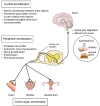Endometriosis-Related Chronic Pelvic Pain
- PMID: 37893241
- PMCID: PMC10603876
- DOI: 10.3390/biomedicines11102868
Endometriosis-Related Chronic Pelvic Pain
Abstract
Endometriosis, which is the presence of endometrial stroma and glands outside the uterus, is one of the most frequently diagnosed gynecologic diseases in reproductive women. Patients with endometriosis suffer from various pain symptoms such as dysmenorrhea, dyspareunia, and chronic pelvic pain. The pathophysiology for chronic pain in patients with endometriosis has not been fully understood. Altered inflammatory responses have been shown to contribute to pain symptoms. Increased secretion of cytokines, angiogenic factors, and nerve growth factors has been suggested to increase pain. Also, altered distribution of nerve fibers may also contribute to chronic pain. Aside from local contributing factors, sensitization of the nervous system is also important in understanding persistent pain in endometriosis. Peripheral sensitization as well as central sensitization have been identified in patients with endometriosis. These sensitizations of the nervous system can also explain increased incidence of comorbidities related to pain such as irritable bowel disease, bladder pain syndrome, and vulvodynia in patients with endometriosis. In conclusion, there are various possible mechanisms behind pain in patients with endometriosis, and understanding these mechanisms can help clinicians understand the nature of the pain symptoms and decide on treatments for endometriosis-related pain symptoms.
Keywords: central sensitization; chronic pelvic pain; cross sensitization; endometriosis; inflammation; peripheral sensitization.
Conflict of interest statement
The authors declare no conflict of interest.
Figures


References
-
- Sampson J.A. iPeritoneal endometriosis due to the menstrual dissemination of endometrial tissue into the peritoneal cavity, w. Am. J. Obstet. Gynecol. 1927;14:422–469. doi: 10.1016/S0002-9378(15)30003-X. - DOI
Publication types
LinkOut - more resources
Full Text Sources

